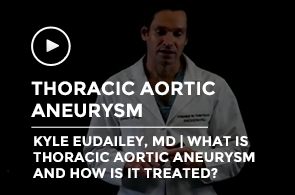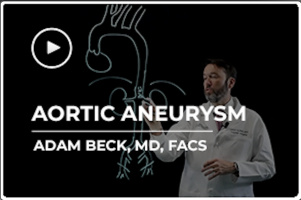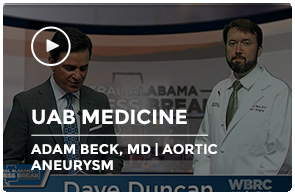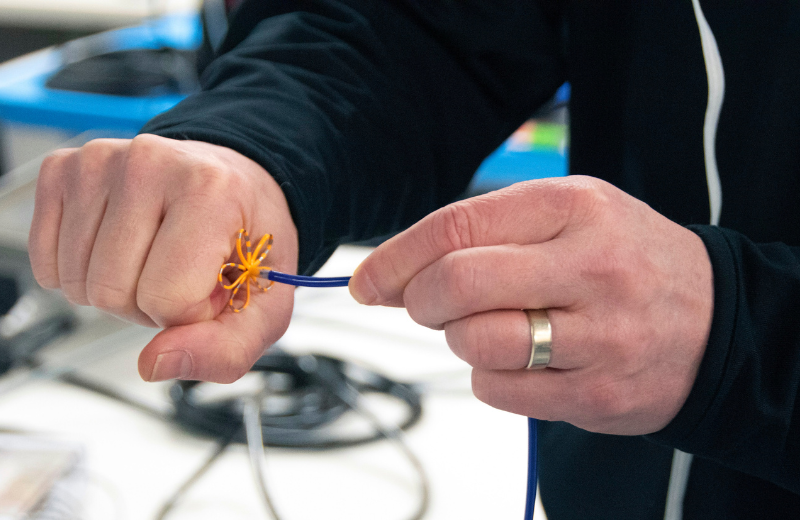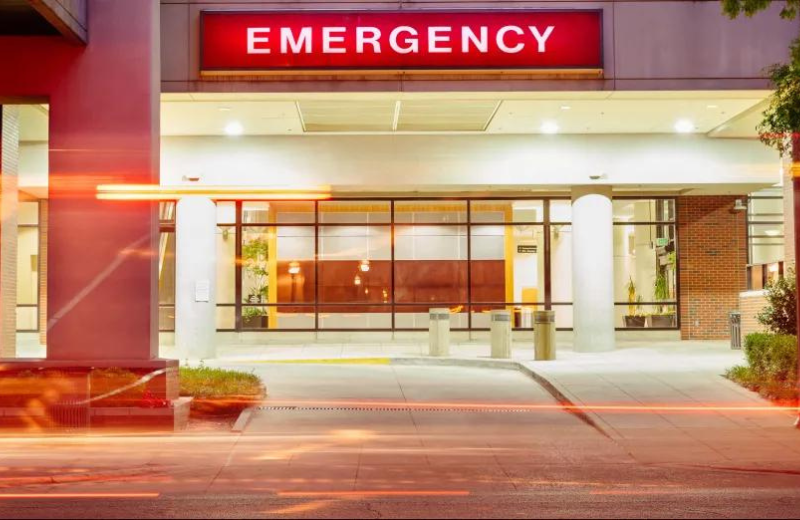An aneurysm occurs when a weakening in the wall of an artery allows the vessel to bulge out like a balloon. Normally this is caused by a combination of potential risk factors including smoking, hypertension, high cholesterol, advanced age, or weak vessels due to conditions such as connective tissue disorders.
Aneurysms can occur in any blood vessel in the body, including arteries and veins. Arteries are the blood vessels that carry oxygen-rich blood from the heart to the rest of the body, and the most common arterial aneurysms are in the brain or aorta. The aorta is the largest artery in the body, arising directly from the heart and providing blood flow through branches to the entire body.
When an aneurysm develops in the aorta, it is called an aortic aneurysm. Because of a risk of rupture leading to internal bleeding and death, it is important to identify and treat aortic aneurysms at the appropriate time. With early detection and proper follow-up, most aneurysms can be repaired when the size of the aneurysm justifies the risk of repair.
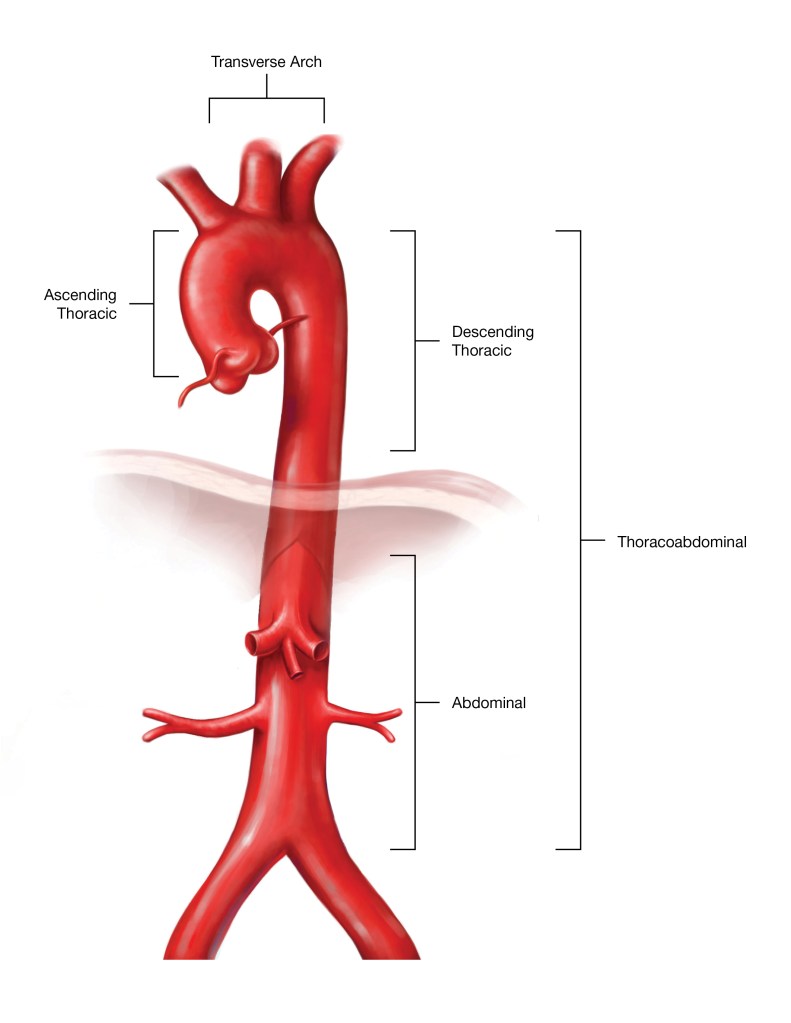
Depending on the location, the cause, and the patient’s overall health state, an aneurysm can be repaired with either traditional “open” surgery or with minimally invasive “endovascular” methods, using smaller incisions and working through the inside of the blood vessels.
During an open aortic aneurysm repair, the weakened area of the aorta is replaced with an artificial tube made of a cloth-like material called Dacron, which is made of woven polyester. Depending on their location, open aneurysm repairs may be performed by either a vascular or cardiovascular surgeon. In some cases, vascular surgeons and cardiac surgeons work together to repair certain types of aortic aneurysms.
Endovascular aneurysm repairs are typically performed by vascular surgeons, and these repairs depend heavily on the anatomy of the blood vessels and the cause of the aneurysm. Compared to open surgery, the minimally invasive procedure normally results in less pain and a faster recovery for the patient, but it cannot be used in all cases.
Aneurysms can occur in any part of the aorta and are characterized by their anatomic location. The aorta is a continuous tube that begins at the heart and ends in the pelvis. It is divided into the thoracic and abdominal sections by the diaphragm where the aorta enters the abdomen from the chest. The thoracic aorta arises from the heart as the ascending aorta, then becomes the transverse aorta or aortic “arch” where the blood vessels to the brain and arms arise, then the descending thoracic aorta as it descends through the chest. The abdominal aorta begins as the aorta passes through the diaphragm.
Aortic aneurysms vary greatly, and the timing and type of repair used often depend on where the aneurysm begins and ends. The various types are discussed below.
Ascending aortic aneurysms
Ascending aortic aneurysms develop in the section of the aorta immediately above the heart. Repairing this type of aneurysm typically requires open surgery, which is most commonly performed by a cardiac surgeon.
Aortic arch aneurysms
Aneurysms in the aortic arch traditionally have been repaired with open methods, but newer endovascular methods are currently in development that allow for minimally invasive treatment of some of these aneurysms. Additionally, “hybrid” open and endovascular procedures are sometimes used to allow for a less invasive option than a traditional open operation. These procedures may require the involvement of both vascular and cardiac surgeons.
Descending thoracic aneurysms
Aneurysms in the descending thoracic aorta are most commonly treated with endovascular methods, but arterial anatomy and cause of the aneurysm may prevent a minimally invasive treatment from being used. Endovascular treatment of these aneurysms is often referred to as “TEVAR,” which stands for thoracic endovascular aortic repair.
Thoracoabdominal aortic aneurysms
Aneurysms that extend from the thoracic aorta through the diaphragm into the abdominal aorta are called thoracoabdominal aneurysms. These are often the most complex type of aortic aneurysm and carry the highest risks associated with repair. Depending on arterial anatomy and cause of the aneurysm, thoracoabdominal aneurysms may be treated with endovascular, open, or hybrid techniques.
Abdominal aortic aneurysms
Abdominal aortic aneurysms, often referred to as AAA, are the most common type of aortic aneurysm and develop in the section of the aorta below the diaphragm and within the abdomen. These aneurysms are most often treated with endovascular methods, but sometimes they must be treated with open surgery for various reasons, which your surgeon can discuss with you in detail. Endovascular treatment of AAA is often referred to as “EVAR,” which stands for endovascular AAA repair.
UAB Medicine’s vascular and cardiac specialists provide expert treatment of aortic aneurysms using minimally invasive endovascular procedures, open surgical reconstruction, or a combination of both techniques, depending on the location and cause of the aneurysms. Repair of complex aneurysms often requires a multidisciplinary approach involving both vascular and cardiac surgeons. Our specialty-trained surgeons and physicians are leaders in their field and have excellent track records in treating some of the most complex vascular diseases and conditions, including aortic aneurysms. That expertise is backed by the latest and most advanced technology, facilities, and treatment options, as well as our dedication to patient-centered care. We confer extensively with each patient to determine a specific diagnosis and treatment plan based on medical history, physical exam, and a variety of non-invasive testing that includes ultrasound, Doppler with plethysmography, CT scans, and magnetic resonance angiography (MRA). We maintain an operating room designed specifically for vascular procedures, where we are able to perform “hybrid” aortic aneurysm repairs, combining both open surgery and minimally invasive endovascular techniques and maximizing the benefits of both. We also employ three-dimensional overlay fusion technology in our state-of-the-art hybrid operating rooms, in which pre-operative imaging is overlaid with images captured during surgery, providing greater accuracy and improved outcomes. As a major academic medical center, UAB maintains an active research program that also manages clinical trials. Our commitment to innovation and discovery often means that patients have access to advanced new treatments long before they are available to the general public.
Videos
Resources
- Division of Vascular Surgery and Endovascular Therapy
- Division of Cardiothoracic Surgery
- Aortic Aneurysm
Clinical Trials
Speak to your physician about your options and browse the link below for more information
Latest News
View All News-
UAB relaunches Women’s Heart Health Program, now accepting patients
March 18, 2024
-
Research shows that Black individuals with a genetic mutation in the TTN gene have increased risk of developing atrial fibrillation, heart failure
March 15, 2024
-
UAB first in state and among first in the nation to use new technology to reduce atrial fibrillation complications
March 13, 2024
-
UAB-led study reveals that tracking troponin I over time is important for managing blood pressure and predicting risk of heart disease
March 12, 2024
-
UAB patient with congenital heart disease shares story to give others hope
February 23, 2024

